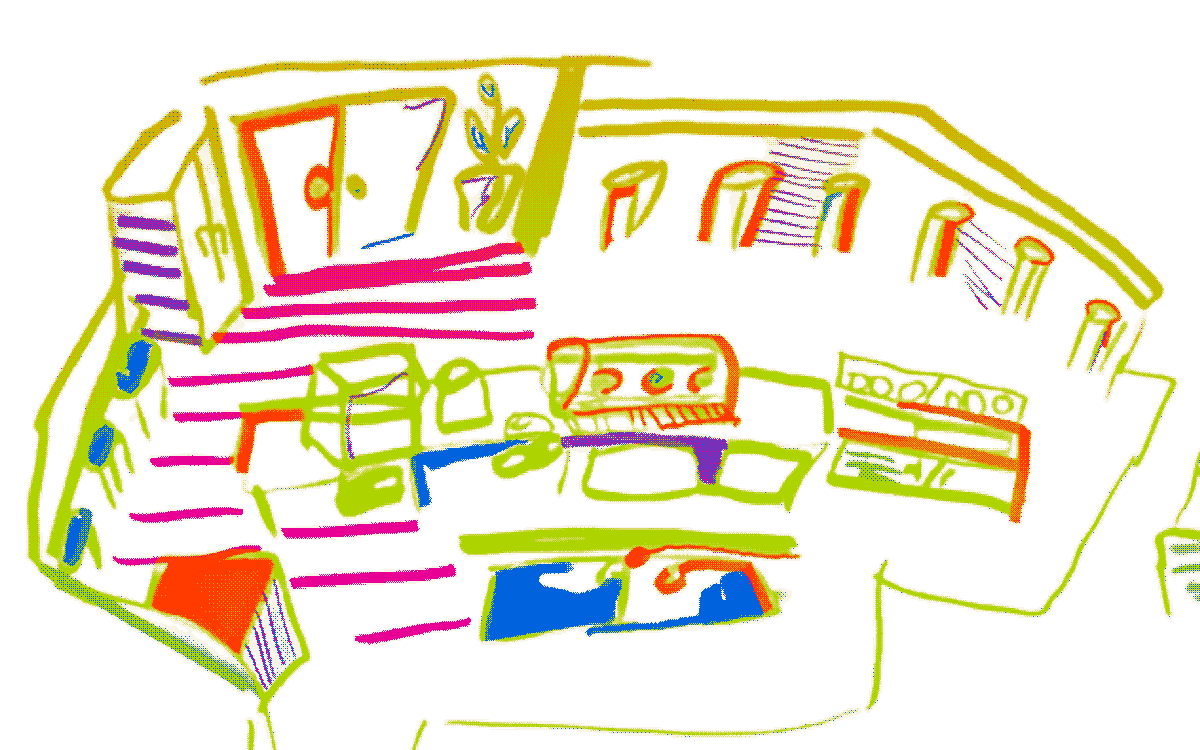No one wants to make bad art. In fact, the only thing more frightening than baring your vulnerabilities through a creative outlet is the possibility of being met with negative feedback once you’ve done so. However, if you ask local Vancouver artists Tereza Tacic and Alice Mackenzie, the quality of the end product is far less important than the joys one encounters throughout the creative process. In December of 2021 the long-time friends started Bad Art, a “multi-platform resource” which aims to connect individuals with their creativity while prioritizing accountability, inclusion, and accessibility. Beyond this, it gets a bit tricky to explain precisely what Bad Art is— scrolling through the front page of their website, you’ll find their services offered to businesses, full time artists, educators, and more.
“Our one thing is that we are a bit of everything,” explains Mackenzie.
This, perhaps, is the best way to describe how Tacic and Mackenzie see Bad Art. Having both been diagnosed with ADHD and autism later in life, they’ve faced no shortage of barriers within the art world, and have thus been tasked with finding ways to create that meet their distinct needs. Through these experiences, the duo recognized a disconcerting truth: often, the people who benefit the most from creative expression feel unable to access it. In an effort to conquer this, Tacic and Mackenzie have developed an outreach program that truly has something for everyone— whether it be free activity guides (available on their website,) or in-person workshops for children and adults alike.
Although making creativity accessible is Bad Art’s primary goal, throughout my conversation with Tacic and Mackenzie I found another recurring theme: the importance of community. They speak to one another in a way that makes both their passion and the longevity of their friendship obvious, frequently finishing each other’s sentences and attributing their accomplishments to the others’ support. As valuable as their advocacy for creative expression is, what’s just as valuable is the space Bad Art provides for individuals to find the kind of community Tacic and Mackenzie have found in one another.
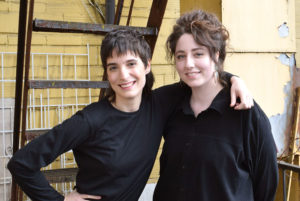
PM: To start, maybe you can tell me a little bit about yourselves individually?
AM: My name is Alice Mackenzie, and I’m an artist. Mostly visual arts, but I’m now painting. I usually go through phases of doing random different things, whatever suits my fancy. I’m also a hairstylist.
TT: My name is Teresa Tacic. My day job is at the Port, I’m involved with the union there. But mostly, it’s a means to an end for art making— mostly painting. I used to do more electronics and robotic stuff in school. But now mostly I just hang out with Ali — like, all the time.
PM: Can you give a brief summary of what Bad Art is all about, and what your goals are?
TT: Bad Art is a term we use for our partnership, as friends, but also as artists. It comes from this place of trying to find extra meaning from all the things we’ve learned from each other. From art-making, and from navigating the world and systems that weren’t made for us. We use art-making as a way of condensing all of that in one place, so it can be easily shared with others, and so hopefully, other people won’t have to start from square one like we did.
AM: Creativity in-and-of itself can grow your world in ways that I don’t think a lot of people understand. And so our goal is to show people that [being creative] is a messy and embarrassing and silly thing to do — but it gives you so much more freedom in life. It doesn’t have to be just within the art world. That kind of creative activation can be taken into any aspect of your life. Our goal in Bad Art is to give that joy of creativity to other people in accessible ways, and for them to take it into their art or just to take it into their everyday life.
TT: We’ve engaged with a lot of people that say “we’re not artists, we’re not creative, I only make bad art.”
AM: Like blah, blah, blah, “I can’t draw.”
TT: We’re like, bullshit! That isn’t real.
AM: We all have innate creativity and to value that is a super incredible, powerful tool.
TT: Not only will it bring joy and ease to your life, but it will also make the shitty things about being alive tolerable. You’ll be able to engage with them in a way that makes it easier to survive and be a person.
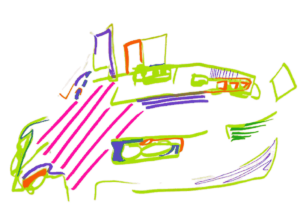
PM: Why do you think it’s important for individuals to incorporate creativity in their day to day lives, even if they don’t necessarily consider themselves to be a creative person? Is your goal to push people out of their comfort zone into creative spaces?
TT: Basically, [when it comes to creativity] there are some bad systems, things that don’t work for you, things that make creativity difficult. To fix this requires creativity, it requires you to be able to imagine beyond the circumstances you’re faced with. By developing your own personal creativity, you can apply it to those large-scale systematic issues, and ultimately make things a little more livable. If you can’t change the systems, you can at least manage navigating them.
PM: What would be an example of a bad system that somebody would have to navigate around?
AM: Well, I can talk about my experience within the art world. I’m autistic and have ADHD, I’m also dyslexic and have dyscalculia. So I’ve always struggled within the system of school. Thankfully — because I have good parents and great friends — I’ve known that I do have value, and I’m a creative person. Even though I’ve had such a hard time navigating these systems, I’ve used creativity, partnership, and friendship, to be able to get through these things. Having the skills to creatively interact with systems to change them, so that they fit for you is super valuable. Before I started my partnership with Tereza, I was really scared of the art world for many reasons. I had a really hard time connecting, talking, and putting myself out there.I have a really hard time with paperwork and grant work. So, having this partnership where we’re thinking collaboratively means we’re not scared to fail because we support each other. It has been a way to navigate the system.
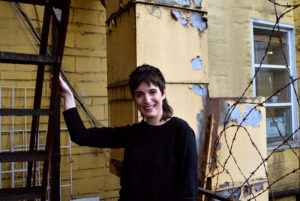
PM: You two place a huge emphasis on accessibility. In addition to some of the things you just mentioned, what do you feel are some of the barriers that prevent individuals from accessing their creativity? And how does Bad Art help people access that part of themselves?
TT: The first thing that comes to mind for me is that I was born in Serbia and moved to Canada when I was really young. I grew up in an immigrant household — my parents worked at Tim Hortons. And they were like, “we love art, and we’d love to be able to make art, but we can’t. We need to pay our bills.” So there’s all these kinds of practical restraints. Luckily, I met Ali back in high school, and Ali was like, “yeah, you can make art.”
AM: Every time we start a project, we think about the criteria of who’s going to be able to access it. We think, “can kids do it? Okay, if kids can’t really do it, is there a way that we can make it so that parents and kids can do it?” The project may be catering more towards the 20-somethings, but [we think about] how we can include other groups. We’re usually thinking about the parameters of age accessibility, of mental and physical accessibility, as well as financial. So it’s like, “how do I give this to the people that need it? Is this going to just be in the art world? How do we bring this outside of the art world? Are we bringing this information to community centers?”We know that we can’t always be accessible to everyone all the time, but [we are] conscious about how and who can access [each project].
TT: One thing that we’re both really aware of is the jargon-y aspects of art education.There are a lot of things people [assume we] know because we went to art school. They’ll be talking about cleaning brushes, and as autistic people, we might not have gotten the memo [that you could use] turpentine to clean them because nobody was like, “hey, by the way, this is what this actually means.”
AM: We often are quite explicit about how we share information, which is, not with the assumption that someone already has a certain kind of background or knowledge. With our worksheets, we try to consider, “is this legible? Could I explain this to my mom?” Or even like, “is this simple for me to read?” We’re really trying to promote accessibility for us, as people with disabilities, to be creative and to be thought of as educators and information sharers, in a way that’s accessible to us [so we can] continue to work within the community.
PM: You’ve already touched on the fact that you’ve both been diagnosed with autism and ADHD — how would you describe the relationship between your creativity and living with these disabilities?
TT: Of course there’s the practical things — like art school being inaccessible. For me, the big thing is social energy [and the] exceptionally finite amount of energy I have. I can’t network to save my life, like, I’ve got a bedtime. So a lot of the more traditional ways of engaging with [an art] practice were seemingly inaccessible. But you know, these diagnoses are pretty new things, and I’m realizing that — let’s say painting specifically, and the kind of way I paint — will always be very impulsive. It’s something that just needs to come out. After all is said and done, I will look at it [and say] “of course I painted this thing. That makes sense.” It’s therapeutic in that way. For me the process of [painting] is super sensory — I’m listening to music while I’m doing it, I’m dancing. And for a second, my brain can percolate. My thoughts can kind of hang back for a while. My art practice has become a therapy.
AM: I think what’s also really great within this idea of understanding our disabilities, and working within them more, is having each other to be that accountability buddy. Where it’s like: “I know you, and I know you need to take a break. I know you need to close your eyes and go sit over there, you’re overstimulated.” So having these diagnoses is really important for us to understand ourselves more. For us to honor ourselves more. Because for so much of our lives, we were hurting and harming ourselves because we didn’t understand ourselves. Now we have a business where our number one [priority] is that it feels right. That we feel like we’re doing the right thing for ourselves, and for each other. Having that is incredible. Like, I would have never been able to write a grant application if I did not have Tereza. I seriously blocked that off completely, like, “that’s never going to be me, whatever.” Having someone support you, and understand you through disability, and still be like: “you know what, you can do it.” I’m able to do so much more than I ever thought that I would be able to.
PM: It seems like you two having each other has been super, super helpful. I feel like through Bad Art you’re providing a jumping-off point for other people to find a similar sense of community.
AM: Exactly. We want to show you this so that you can do this for yourself. We’re harvesting this for us, but we’re also harvesting it for you. I hope you see what we have, and I hope that you can see that you can have it in whatever way you need it to be for you, because it’s going to be different for everyone.
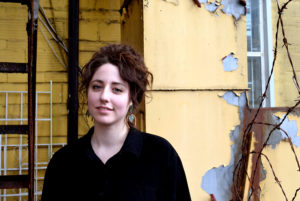
PM: I know you’re really just getting started, but in your plans or dreams for the future, where do you see this organization going?
AM: I think we usually just go wherever we’re able to go. When we get excited about something [we roll] with it — doing it in small bursts so that we can change and grow. We love small projects. We love working with people. And so I think the goal of Bad Art is to be able to do the stuff that is important for us at that moment, and to continue to be able to do that in ways that are accessible to us.
PM: Which makes sense, since everything you do is based around accessibility— you simply do what you’re able to do.
AM: And we always put our lives and our bodies ahead of profit. I think that’s the number one thing for us: we have to take care of ourselves. I see Bad Art as being something that’s ever-changing.
TT: Learning, for each of us, is very much a non-negotiable of life. It’s a top priority in so many ways. In learning for ourselves via Bad Art, and sharing that with others is maybe the ultimate thing that keeps us growing. What else can we learn? What else can we share?


